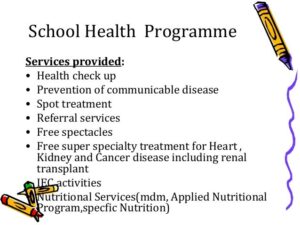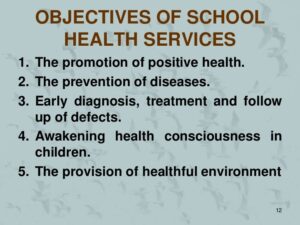Back to: Physical and Health Education JSS 2
Welcome to class!
In today’s class, we shall be talking about the goals and objectives of school health programmes. Please enjoy the class!
Goals and Objectives of School Health Programmes
Imagine a school where physical and mental health are woven into the very fabric of the learning experience. This is the vision of school health programs, meticulously designed initiatives that go beyond textbooks and tests to equip students with the knowledge, skills, and attitudes for lifelong well-being. Join us as we delve into the fascinating world of school health programs, exploring their goals and objectives!

Goals Galore: What School Health Programs Aim to Achieve
School health programs aren’t one-size-fits-all. They adapt to cater to the diverse needs of students at different age groups and address a wide range of goals. Here are some key focus areas:
Promoting health and wellness: This encompasses fostering healthy habits like physical activity, nutritious eating, and adequate sleep. Think sunshine breaks, healthy cafeteria options, and mindfulness exercises integrated into the school day!
Preventing illness and injury: From promoting hygiene practices to teaching safety protocols, school health programs aim to keep students safe and healthy, minimizing the spread of germs and reducing the risk of accidents.
Developing healthy decision-making: Equipping students with the knowledge and critical thinking skills to make informed choices about their health, from understanding substance abuse risks to navigating social pressure, is crucial.
Creating a supportive school environment: A school that prioritizes mental health awareness, provides access to counseling services, and fosters inclusivity can significantly impact students’ overall well-being.
Objectives in Action: Bringing Goals to Life

So, how do these lofty goals translate into concrete actions? School health programs employ a diverse toolbox of strategies, including:
Health education: Interactive lessons, engaging workshops, and age-appropriate curriculum materials provide students with valuable knowledge about physical and mental health.
Physical activity and nutrition programs: Promoting regular physical activity through sports, recreational activities, and movement breaks, along with offering healthy meal options in the cafeteria, sets the stage for healthy habits.
School health services: Providing access to basic healthcare services like screenings, immunizations, and mental health counseling ensures students receive essential care.
Family and community partnerships: Collaborating with families and community organizations strengthens the impact of school health programs and creates a supportive network for student well-being.
Remember: Effective school health programs are evidence-based, culturally relevant, and continuously evaluated to ensure they meet the evolving needs of students and the school community.
By understanding the goals and objectives of school health programs, we can actively contribute to creating nurturing learning environments that foster the physical and mental well-being of future generations. Let’s embrace the power of education to empower students to make healthy choices and lead fulfilling lives!
We have come to the end of today’s class. I hope you enjoyed the class!
In case you require further assistance or have any questions, feel free to ask in the comment section below, and trust us to respond as soon as possible. Cheers!
Question Time:
- Imagine you’re designing a school health program for elementary school students. What are three key health topics you would focus on and why? How would you make your program engaging and interactive for young learners?
- Compare and contrast the goals of school health programs for middle school and high school students. What specific challenges and needs do each age group face, and how can the programs be tailored accordingly?
